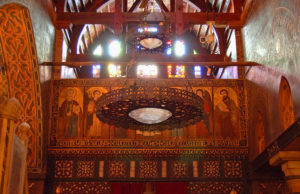
Interior of Cairo’s Hanging Church (Photo by Don Knebel)
Built as early as the seventh century, the church rests on a foundation of logs and stone extended between the tops of the south gate towers of the Roman-era Babylon Fortress, creating the illusion that the church was suspended in the air and giving the church the name Al-Muallaka, meaning “the Hanging” or “the Suspended.” Centuries of accumulated debris have raised the ground level around the church by about 20 feet, nearly burying the towers and eliminating the illusion, but entering the church still requires climbing 29 steps.
The interior of the church has been remodeled repeatedly, but one of its most distinctive features remains. The vaulted wooden ceiling is reportedly intended to suggest an inverted Noah’s ark. Seven huge icons above the altar are among the church’s 110 icons, one of which, called the “Coptic Mona Lisa” because of its iconic portrayal of Mary and the infant Jesus, was created in the eighth century. In the late tenth century, the Fatimid Caliph who ruled Cairo reportedly challenged Patriarch Abraham, who had recently remodeled the church, to prove that faith could move mountains, as Jesus had taught. Copts believe that after Abraham prayed for three days to Mary’s icon, she appeared and gave him the power to cause a section of a mountain near Cairo to break off and move, earning the Caliph’s favor. Whether or not the story is true, the Hanging Church remains a symbol of the ongoing Christian history of Egypt and the mountain is still called “Mokattam,” meaning “broken off mountain.”